2016 NISSAN MURANO HYBRID fog light
[x] Cancel search: fog lightPage 223 of 443
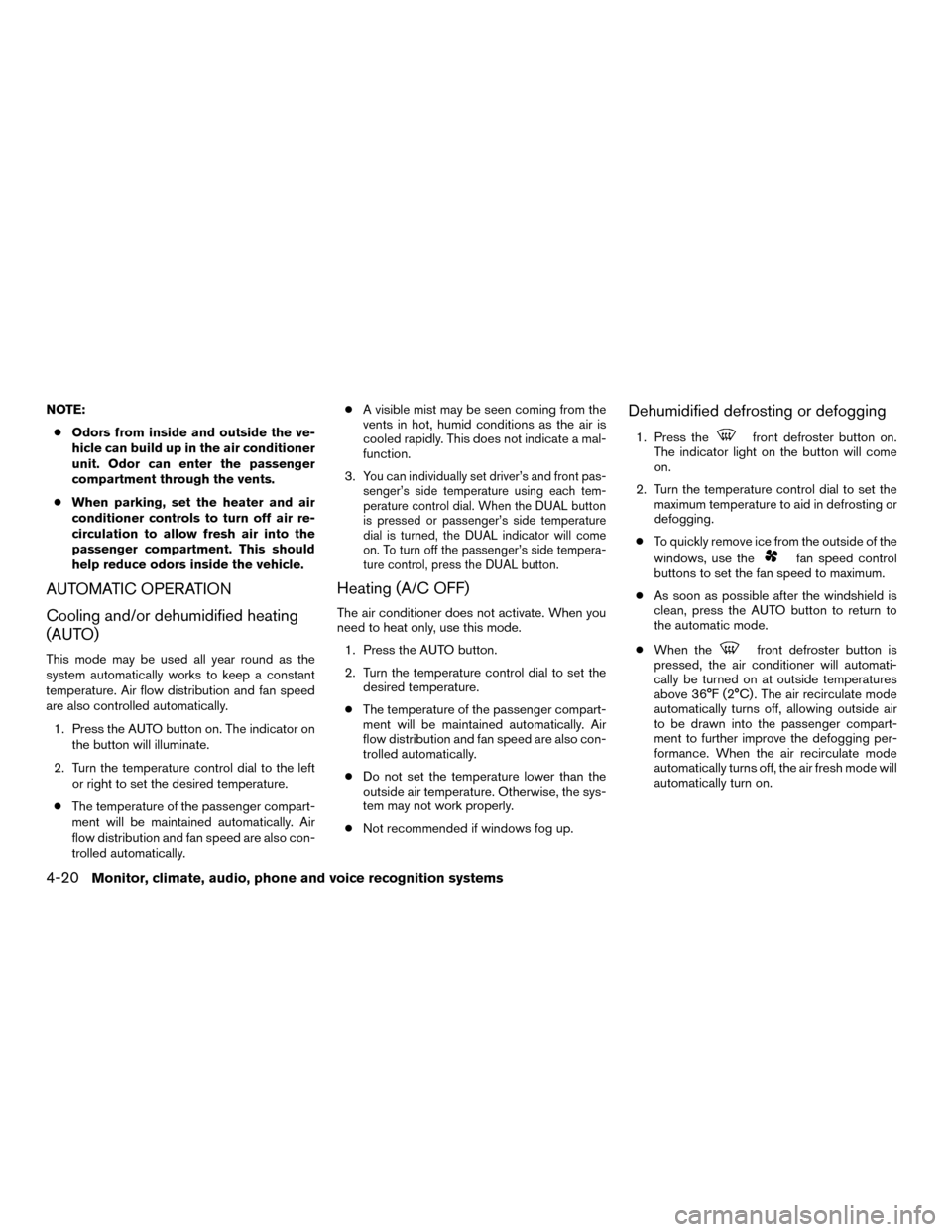
NOTE:● Odors from inside and outside the ve-
hicle can build up in the air conditioner
unit. Odor can enter the passenger
compartment through the vents.
● When parking, set the heater and air
conditioner controls to turn off air re-
circulation to allow fresh air into the
passenger compartment. This should
help reduce odors inside the vehicle.
AUTOMATIC OPERATION
Cooling and/or dehumidified heating
(AUTO)
This mode may be used all year round as the
system automatically works to keep a constant
temperature. Air flow distribution and fan speed
are also controlled automatically.
1. Press the AUTO button on. The indicator on the button will illuminate.
2. Turn the temperature control dial to the left or right to set the desired temperature.
● The temperature of the passenger compart-
ment will be maintained automatically. Air
flow distribution and fan speed are also con-
trolled automatically. ●
A visible mist may be seen coming from the
vents in hot, humid conditions as the air is
cooled rapidly. This does not indicate a mal-
function.
3.
You can individually set driver’s and front pas-
senger’s side temperature using each tem-
perature control dial. When the DUAL button
is pressed or passenger’s side temperature
dial is turned, the DUAL indicator will come
on. To turn off the passenger’s side tempera-
ture control, press the DUAL button.
Heating (A/C OFF)
The air conditioner does not activate. When you
need to heat only, use this mode. 1. Press the AUTO button.
2. Turn the temperature control dial to set the desired temperature.
● The temperature of the passenger compart-
ment will be maintained automatically. Air
flow distribution and fan speed are also con-
trolled automatically.
● Do not set the temperature lower than the
outside air temperature. Otherwise, the sys-
tem may not work properly.
● Not recommended if windows fog up.
Dehumidified defrosting or defogging
1. Press thefront defroster button on.
The indicator light on the button will come
on.
2. Turn the temperature control dial to set the maximum temperature to aid in defrosting or
defogging.
● To quickly remove ice from the outside of the
windows, use the
fan speed control
buttons to set the fan speed to maximum.
● As soon as possible after the windshield is
clean, press the AUTO button to return to
the automatic mode.
● When the
front defroster button is
pressed, the air conditioner will automati-
cally be turned on at outside temperatures
above 36°F (2°C) . The air recirculate mode
automatically turns off, allowing outside air
to be drawn into the passenger compart-
ment to further improve the defogging per-
formance. When the air recirculate mode
automatically turns off, the air fresh mode will
automatically turn on.
4-20Monitor, climate, audio, phone and voice recognition systems
Page 280 of 443
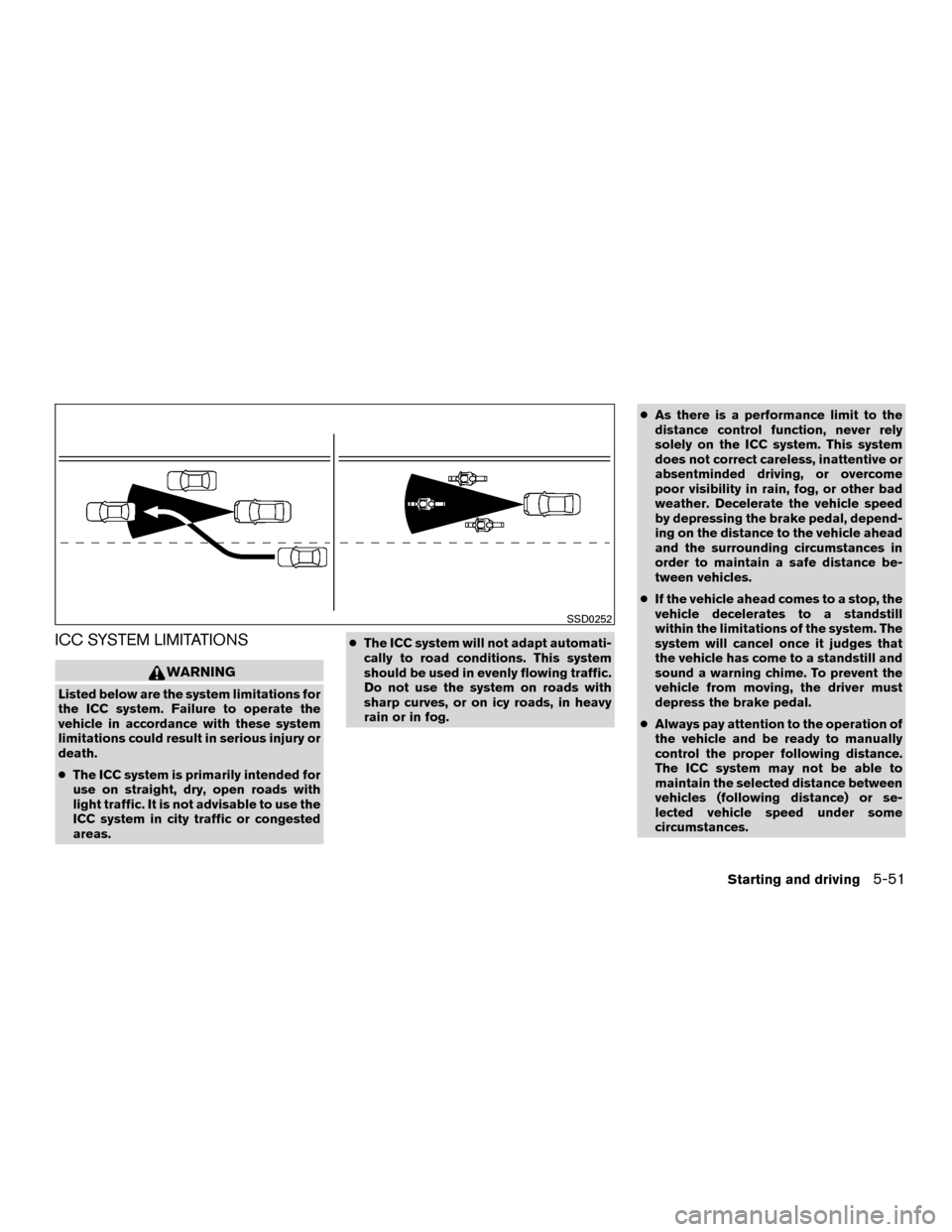
ICC SYSTEM LIMITATIONS
WARNING
Listed below are the system limitations for
the ICC system. Failure to operate the
vehicle in accordance with these system
limitations could result in serious injury or
death.
●The ICC system is primarily intended for
use on straight, dry, open roads with
light traffic. It is not advisable to use the
ICC system in city traffic or congested
areas. ●
The ICC system will not adapt automati-
cally to road conditions. This system
should be used in evenly flowing traffic.
Do not use the system on roads with
sharp curves, or on icy roads, in heavy
rain or in fog. ●
As there is a performance limit to the
distance control function, never rely
solely on the ICC system. This system
does not correct careless, inattentive or
absentminded driving, or overcome
poor visibility in rain, fog, or other bad
weather. Decelerate the vehicle speed
by depressing the brake pedal, depend-
ing on the distance to the vehicle ahead
and the surrounding circumstances in
order to maintain a safe distance be-
tween vehicles.
● If the vehicle ahead comes to a stop, the
vehicle decelerates to a standstill
within the limitations of the system. The
system will cancel once it judges that
the vehicle has come to a standstill and
sound a warning chime. To prevent the
vehicle from moving, the driver must
depress the brake pedal.
● Always pay attention to the operation of
the vehicle and be ready to manually
control the proper following distance.
The ICC system may not be able to
maintain the selected distance between
vehicles (following distance) or se-
lected vehicle speed under some
circumstances.
SSD0252
Starting and driving5-51
Page 346 of 443

8 Maintenance and do-it-yourself
Maintenance requirements..........................8-2
General maintenance ..............................8-2
Explanation of general maintenance items .........8-2
Maintenance precautions ...........................8-5
Engine compartment check locations ................8-7
Engine cooling system .............................8-8
Checking engine coolant level ...................8-9
Changing engine coolant ........................8-9
Inverter cooling system ............................ 8-10
Checking inverter coolant level ..................8-10
Changing inverter coolant ......................8-11
Engine oil ........................................ 8-11
Checking engine oil level .......................8-11
Changing engine oil ........................... 8-12
Changing engine oil filter .......................8-13
Continuously Variable Transmission (CVT) fluid ......8-14
Power steering fluid ............................... 8-15
Brake fluid ....................................... 8-15
Windshield-washer fluid ........................... 8-16
Windshield-washer fluid reservoir ...............8-16
12-Volt Battery ................................... 8-17
Jump starting ................................. 8-18
Drive belt ........................................ 8-19Spark plugs
...................................... 8-19
Replacing spark plugs ......................... 8-19
Air cleaner ....................................... 8-20
In-cabin microfilter ............................. 8-20
Windshield wiper blades .......................... 8-21
Cleaning ..................................... 8-21
Replacing .................................... 8-21
Brakes .......................................... 8-23
Fuses ........................................... 8-23
Engine compartment ........................... 8-24
Passenger compartment .......................8-25
Battery replacement .............................. 8-26
NISSAN Intelligent Key® .......................8-27
Lights ........................................... 8-28
Headlights .................................... 8-28
Fog lights ..................................... 8-29
Exterior and
interior lights ....................... 8-30
Wheels and tires ................................. 8-32
Tire pressure .................................. 8-32
Tire labeling ................................... 8-35
Types of tires .................................. 8-38
Tire chains .................................... 8-39
Changing wheels and tires .....................8-40
Page 374 of 443
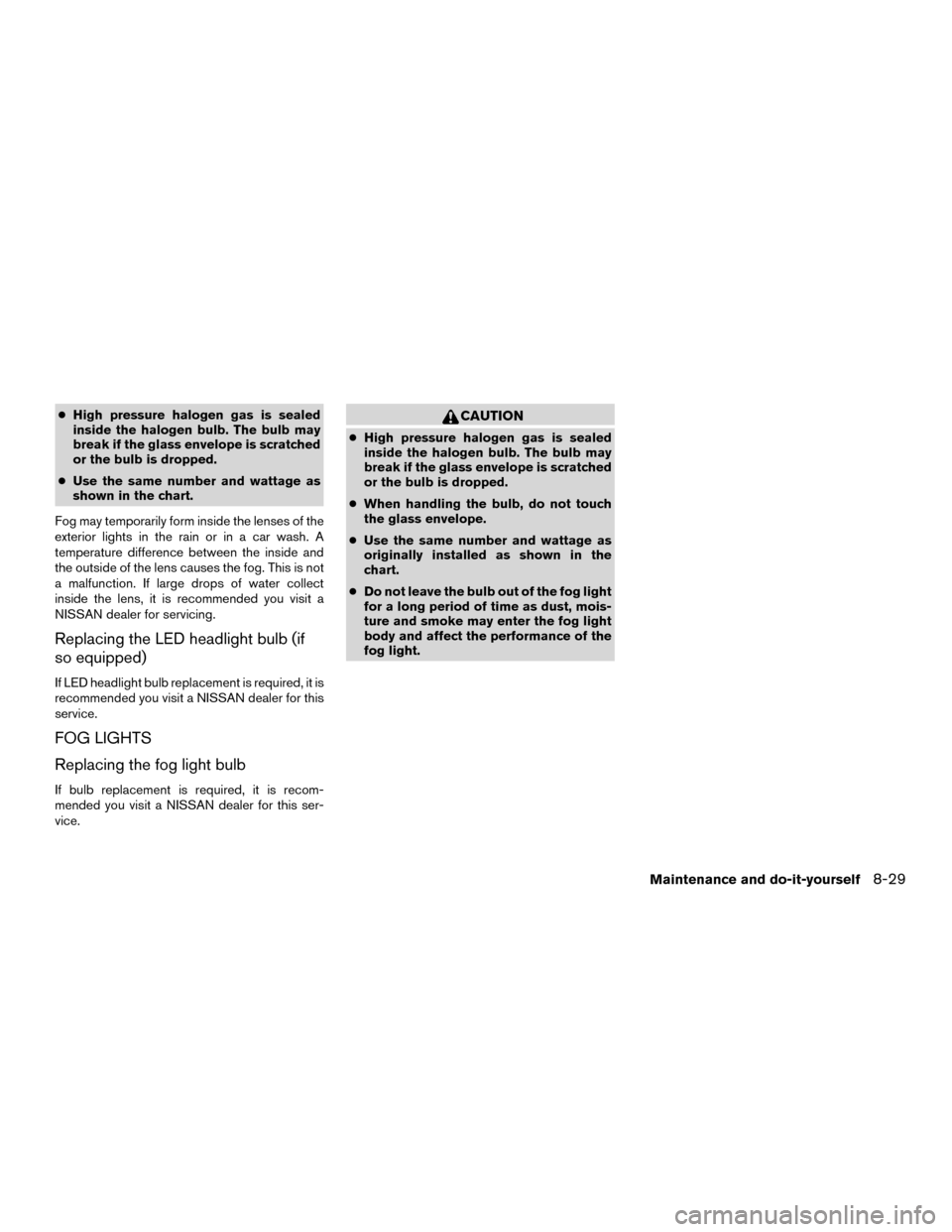
●High pressure halogen gas is sealed
inside the halogen bulb. The bulb may
break if the glass envelope is scratched
or the bulb is dropped.
● Use the same number and wattage as
shown in the chart.
Fog may temporarily form inside the lenses of the
exterior lights in the rain or in a car wash. A
temperature difference between the inside and
the outside of the lens causes the fog. This is not
a malfunction. If large drops of water collect
inside the lens, it is recommended you visit a
NISSAN dealer for servicing.
Replacing the LED headlight bulb (if
so equipped)
If LED headlight bulb replacement is required, it is
recommended you visit a NISSAN dealer for this
service.
FOG LIGHTS
Replacing the fog light bulb
If bulb replacement is required, it is recom-
mended you visit a NISSAN dealer for this ser-
vice.
CAUTION
● High pressure halogen gas is sealed
inside the halogen bulb. The bulb may
break if the glass envelope is scratched
or the bulb is dropped.
● When handling the bulb, do not touch
the glass envelope.
● Use the same number and wattage as
originally installed as shown in the
chart.
● Do not leave the bulb out of the fog light
for a long period of time as dust, mois-
ture and smoke may enter the fog light
body and affect the performance of the
fog light.
Maintenance and do-it-yourself8-29
Page 375 of 443
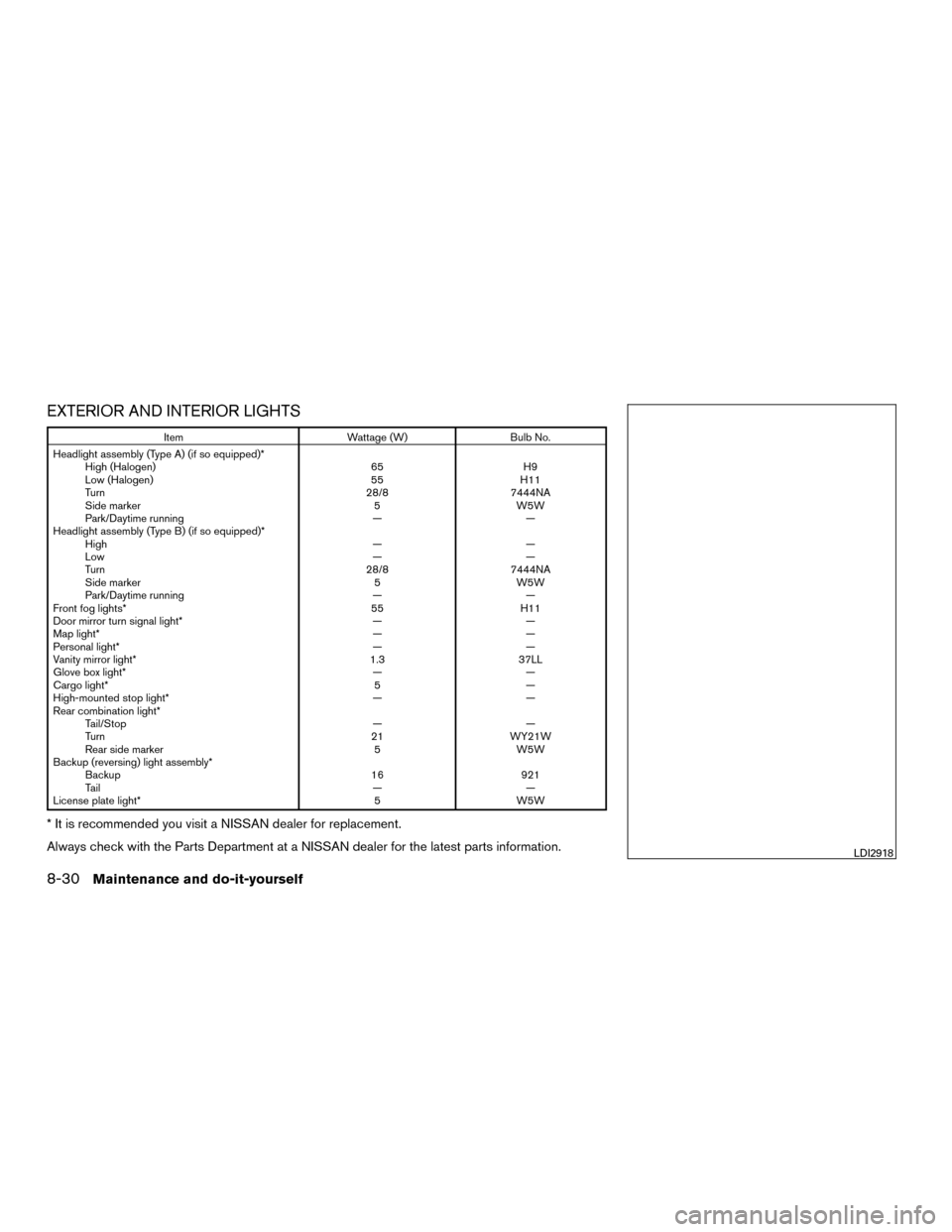
EXTERIOR AND INTERIOR LIGHTS
ItemWattage (W)Bulb No.
Headlight assembly (Type A) (if so equipped)* High (Halogen) 65H9
Low (Halogen) 55H11
Turn 28/87444NA
Side marker 5W5W
Park/Daytime running ——
Headlight assembly (Type B) (if so equipped)* High ——
Low ——
Turn 28/87444NA
Side marker 5W5W
Park/Daytime running ——
Front fog lights* 55H11
Door mirror turn signal light* ——
Map light* ——
Personal light* ——
Vanity mirror light* 1.337LL
Glove box light* ——
Cargo light* 5—
High-mounted stop light* ——
Rear combination light* Tail/Stop ——
Turn 21WY21W
Rear side marker 5W5W
Backup (reversing) light assembly* Backup 16921
Tail ——
License plate light* 5W5W
* It is recommended you visit a NISSAN dealer for replacement.
Always check with the Parts Department at a NISSAN dealer for the latest parts information.
LDI2918
8-30Maintenance and do-it-yourself
Page 376 of 443
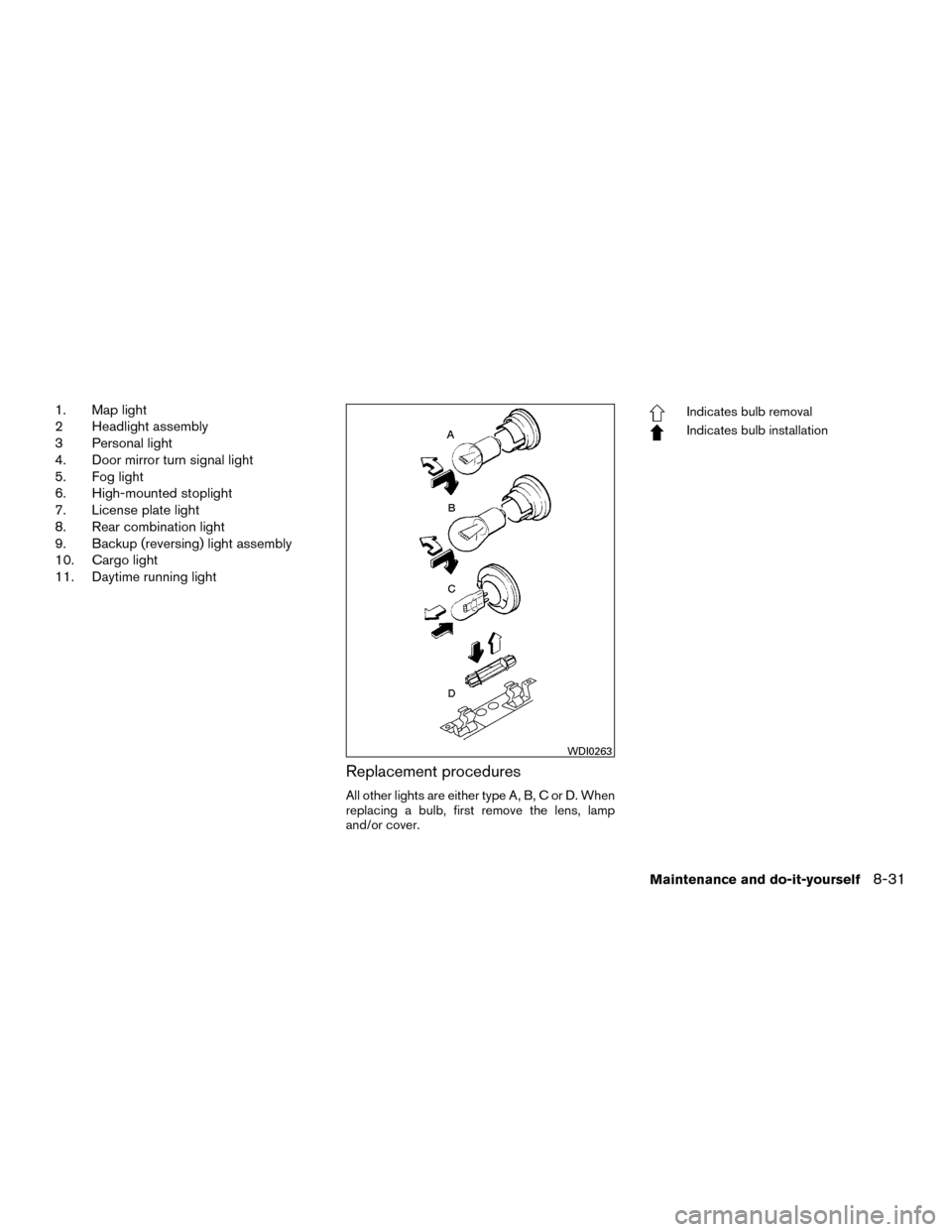
1. Map light
2 Headlight assembly
3 Personal light
4. Door mirror turn signal light
5. Fog light
6. High-mounted stoplight
7. License plate light
8. Rear combination light
9. Backup (reversing) light assembly
10. Cargo light
11. Daytime running light
Replacement procedures
All other lights are either type A, B, C or D. When
replacing a bulb, first remove the lens, lamp
and/or cover.
Indicates bulb removal
Indicates bulb installation
WDI0263
Maintenance and do-it-yourself8-31
Page 421 of 443

Continuously Variable Transmission (CVT)
fluid......................8-14
Driving with Continuously Variable
Transmission (CVT) .............5-16
Controls Heater and air conditioner controls .....4-20
Coolant Capacities and recommended
fuel/lubricants .................9-2
Changing engine coolant ...........8-9
Checking engine coolant level ........8-9
Checking inverter coolant level .......8-10
Corrosion protection ...............7-6
Cruise control ..................5-40
Cup holders ...................2-51
D
Daytime running light system (Canada only) . .2-39
Defroster switch Rear window and outside mirror defroster
switch .....................2-37
Dimensions and weights .............9-9
Dimmer switch for instrument panel ......2-40
Door locks .....................3-4
Doors ........................3-4
Drive belt .....................8-19
Drive positioner, Automatic . . . .3-34, 3-35, 3-36
Driving Cold weather driving .............5-89
Driving with Continuously Variable
Transmission (CVT) .............5-16
Precautions when starting and
driving ...................5-2, 5-9
Driving the vehicle ................5-16 E
Economy - fuel ..................5-79
Emergency engine shutoff ............6-2
Emission control information label .......9-11
Emission control system warranty .......9-27
Engine Before starting the engine ..........5-14
Capacities and recommended
fuel/lubricants .................9-2
Changing engine coolant ...........8-9
Changing engine oil .............8-12
Changing engine oil filter ..........8-13
Checking engine coolant level ........8-9
Checking engine oil level ..........8-11
Engine compartment check
locations . . . .8-7
Engine cooling system ............8-8
Engine oil ...................8-11
Engine oil and oil filter recommendation . . .9-6
Engine oil pressure warning light .......2-9
Engine oil viscosity ..............9-7
Engine serial number ............9-11
Engine specifications .............9-8
Starting the engine .............5-15
Event Data recorders ..............9-29
Exhaust gas (Carbon monoxide) .........5-2
Explanation of maintenance items ........8-2
Extended storage switch ............2-48
F
Flashers (See hazard warning flasher switch) . .6-2
Flat tire .......................6-3
Floor mat positioning aid .............7-5 Fluid
Brake fluid ..................8-15
Capacities and recommended
fuel/lubricants .................9-2
Continuously Variable Transmission (CVT)
fluid ......................8-14
Engine coolant .................8-8
Engine oil ...................8-11
Inverter coolant ................8-10
Power steering fluid .............8-15
Windshield-washer fluid ...........8-16
F.M.V.S.S. certification label ...........9-11
Fog light switch .................2-41
Forward Emergency Braking (FEB) .......2-9
Front air bag system
(See supplemental restraint system) ......1-54
Front power seat adjustment ...........1-3
Front seats .....................1-2
Fuel Capacities and recommended
fuel/lubricants .................9-2
Fuel economy ................5-79
Fuel-filler door and cap ...........3-26
Fuel-filler door lock opener lever ......3-26
Fuel gauge .................. .2-6
Fuel
octane rating ...............9-5
Fuel recommendation .............9-4
Loose fuel cap warning ...........2-25
Fuel Cell Vehicle (FCV) System Tire pressure .................8-32
Fuel-filler door ..................3-26
Fuel gauge .....................2-6
Fuses .......................8-23
Fusible links ...................8-25
10-2
Page 423 of 443
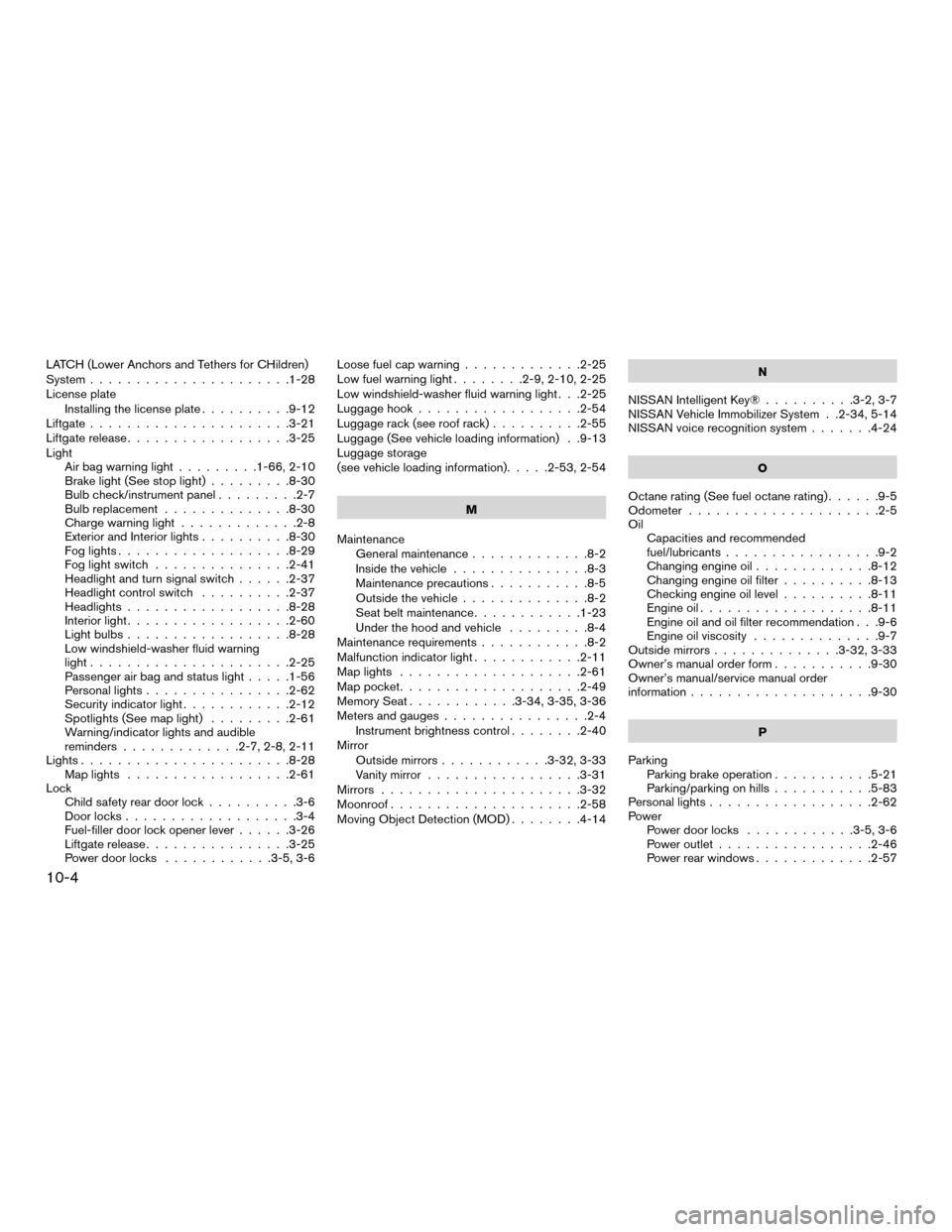
LATCH (Lower Anchors and Tethers for CHildren)
System......................1-28
License plate Installing the license plate ..........9-12
Liftgate ......................3-21
Liftgate release ..................3-25
Light Air bag warning light .........1-66, 2-10
Brake light (See stop light) .........8-30
Bulb check/instrument panel .........2-7
Bulb replacement ..............8-30
Charge warning light .............2-8
Exterior and Interior lights ..........8-30
Fog lights ...................8-29
Fog light switch ...............2-41
Headlight and turn signal switch ......2-37
Headlight control switch ..........2-37
Headlights ..................8-28
Interior light ..................2-60
Light bulbs ..................8-28
Low windshield-washer fluid warning
light ......................2-25
Passenger air bag and status light .....1-56
Personal lights ................2-62
Security indicator light ............2-12
Spotlights (See map light) .........2-61
Warning/indicator lights and audible
reminders .............2-7, 2-8, 2-11
Lights .......................8-28
Map lights ..................2-61
Lock Child safety rear door lock ..........3-6
Door locks ...................3-4
Fuel-filler door lock opener lever ......3-26
Liftgate release ................3-25
Power door locks ............3-5, 3-6 Loose fuel cap warning
.............2-25
Low fuel warning light ........2-9, 2-10, 2-25
Low windshield-washer fluid warning light . . .2-25
Luggage hook ..................2-54
Luggage rack(see
roof rack)..........2-55
Luggage (See vehicle loading information) . .9-13
Luggage storage
(see vehicle loading information) .....2-53, 2-54
M
Maintenance General maintenance .............8-2
Inside the vehicle ...............8-3
Maintenance precautions ...........8-5
Outside the vehicle ..............8-2
Seat belt maintenance ............1-23
Under the hood and vehicle .........8-4
Maintenance requirements ............8-2
Malfunction indicator light ............2-11
Map lights ....................2-61
Map pocket ....................2-49
Memory Seat ............3-34, 3-35, 3-36
Meters and gauges ................2-4
Instrument brightness control ........2-40
Mirror Outside mirrors ............3-32, 3-33
Vanity mirror .................3-31
Mirrors ......................3-32
Moonroof .....................2-58
Moving Object Detection (MOD) ........4-14 N
NISSAN Intelligent Key® ..........3-2, 3-7
NISSAN Vehicle Immobilizer System . .2-34, 5-14
NISSAN voice recognition system .......4-24
O
Octane rating (See fuel octane rating) ......9-5
Odometer .....................2-5
Oil Capacities and recommended
fuel/lubricants .................9-2
Changing engine oil .............8-12
Changing engine oil filter ..........8-13
Checking engine oil level ..........8-11
Engine oil ...................8-11
Engine oil and oil filter recommendation . . .9-6
Engine oil viscosity ..............9-7
Outside mirrors ..............3-32, 3-33
Owner’s manualorder
form ...........9-30
Owner’s manual/service manual order
information ....................9-30
P
Parking Parking brake operation ...........5-21
Parking/parking on hills ...........5-83
Personal lights ..................2-62
Power Power door locks ............3-5, 3-6
Power outlet .................2-46
Power rear windows .............2-57
10-4